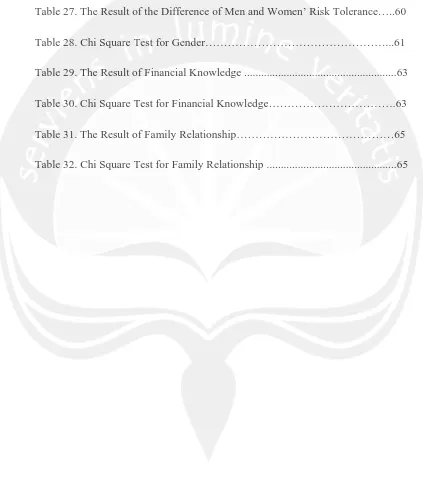THE IMPACT OF FAMILY RELATIONSHIP, GENDER, AND
FINANCIAL KNOWLEDGE ON FINANCIAL RISK TOLERANCE
THESIS
Presented as Partial Fulfillment of the Requirements for the Degree of
Sarjana Ekonomi (S1)
In International Business Management Program
Faculty of Economics Universitas Atma Jaya Yogyakarta
Compiled by:
Karina Irene Purnamasari
Student ID Number: 09 12 17608
FACULTY OF ECONOMICS
ACKNOWLEDGEMENT
First of all, I wants to give thanks to Jesus Christ, my Lord for His love,
blessing and guidance, so I can finish this thesis as well as whole study at
Universitas Atma Jaya Yogyakarta. There are so many things that have been
through since my first day at Universitas Atma Jaya Yogyakarta and finish this
thesis will be the best thing during study here.
This thesis, entitled “THE IMPACT OF FAMILY RELATIONSHIP,
GENDER, AND FINANCIAL KNOWLEDGE ON FINANCIAL RISK
TOLERANCE”, compiled as fulfillment of the requirement for Degree of Sarjana
Ekonomi (S1) in Management Program.
I realizes that there are many people who have given their support and
help within the compilation of this thesis. Hence, I dedicates these pages to them:
1. My parents for the love, patience, prayers, trust, and endless support
especially during my hard time. For my lovely sisters, Opi and Icha who
always pray for me, support me, and encourage me. Without all of you, I
will not able to finish the study in Universitas Atma Jaya Yogyakarta.
2. My advisor, Mr. Alexander Djatmiko Wibowo, SE.,SIP.,MSF. For
lecturing and the guidance in this thesis. Thank you for your willingness to
spare time to guide me to finish this thesis. Your patience, suggestion,
understanding, and advance in guiding me through the process in
3. All my lecturers in Economic Faculty in international and regular class
that I cannot mention one by one. Thank you for giving me experience,
skill, and knowledge during study in Universitas Atma Jaya Yogyakarta.
4. My best friends Mita, Maria, Ria, Ina, Adrian, Ongky, Yoha, Aldo, and
Ayu Bola who always support, help and advice me in the hard time.
5. All of my lovely friends, especially IBMP students:
a. Andra, Cynthia, Adis, Yoan who always support me, especially in the
hard time. And thanks for all experiences that we shared and advice.
b. Thanks to Yoanna & Yessa, for struggling together to finish the thesis.
c. Adit, Dora, Yugo, Rani, Felani, Dedy, Dea, Sherley, Febrian, Bast,
Elida to bring me the happiness and unforgettable experiences within
studying in Universitas Atma Jaya Yogyakarta.
6. All my KKN friends in Bulurejo, Saptosari, Rinto, Ivan, Alex, Vani,
Maria, Meilisa, Indra, Andrew, and Dody who give me unforgettable
experiences and joy that we have faced together during KKN.
7. Mas Adit who always helps and guides patiently in international office.
8. For all people that I could not mention one by one. Thank you for your
support and care.
Regards,
TABLE OF CONTENT
TITLE PAGE ... i
APPROVAL PAGE ... ii
COMMITTEE’S APPROVAL PAGE ... iii
AUTHENTICITY ACKNOWLEDGEMENT ... iv
ACKNOWLEDGEMENT ... v
TABLE OF CONTENT ... vii
LIST OF TABLES ... xi
LIST OF FIGURE ... xiii
LIST OF APPENDICES ... xiv
ABSTRACT ... xv
CHAPTER I: INTRODUCTION ... 1
1.1 Background ... 1
1.2 Problem Statement ... 5
1.3 Research Scope ... 6
1.4 Objectives and Benefits of Research ... 7
1.4.1 Objectives of the Research ... 7
1.4.2 Benefits of the Research ... 7
1.5 Research Originality ... 9
CHAPTER II: THEORETICAL BACKGROUND AND PREVIOUS
RESEARCH ... 11
2.1 Theoretical Background ... 11
2.1.1 Family Relationship ... 11
2.1.2 Financial Knowledge ... 14
2.1.3 Gender ... 15
2.1.4 Financial Risk Tolerance ... 16
2.2 Previous Research ... 18
2.3 Operational Definition ... 25
2.4 Hypotheses ... 29
CHAPTER III: RESEARCH METHODOLOGY ... 30
3.1 Population and Sample ... 30
3.2 Data and Data Gathering ... 31
3.2.1 Data ... 31
3.2.2 Data Gathering ... 31
3.3 Measurement Scale and Variable Measurement ... 32
3.3.1 Measurement Scale ... 32
3.3.2 Variable Measurement ... 33
3.4 Validity and Reliability Test ... 36
3.5 Method of Analysis ... 37
3.5.1 Descriptive Statistics ... 37
CHAPTER IV: DATA ANALYSIS ... 39
4.1 Validity and Reliability Testing ... 39
4.1.1 Reliability Testing ... 39
4.1.1.1 Reliability Testing of Family Relationship ... 39
4.1.1.2 Reliability Testing of Financial Risk Tolerance ... 40
4.1.1.3 Reliability Testing of Financial Knowledge ... 40
4.1.2 Validity Testing ... 40
4.1.2.1 Validity Testing of Family Relationship ... 41
4.1.2.2 Validity Testing of Financial Risk Tolerance ... 41
4.1.2.3 Validity Testing of Financial Knowledge ... 42
4.2 Descriptive Statistics ... 42
4.2.1 Descriptive Statistics Based on Gender ... 43
4.2.2 Descriptive Statistics Based on Major ... 44
4.2.3 Descriptive Statistics Based on Financial Subject ... 45
4.2.4 Descriptive Statistics Based on Parents’ Last Education .... 47
4.2.5 Descriptive Statistics Based on Parents’ Occupation ... 49
4.3 Hypotheses Testing ... 51
4.3.1 Hypothesis 1 (Ha1) ... 51
4.3.2 Hypothesis 2 (Ha2) ... 60
4.3.3 Hypothesis 3 (Ha3) ... 62
4.3.4 Hypothesis 4 (Ha4) ... 64
CHAPTER V: CONCLUSION, LIMITATION, AND SUGGESTION ... 67
5.3 Limitation of the Research ... 69
5.4 Suggestion ... 69
BIBLIOGRAPHY ... 70
LIST OF TABLES
Table 1. The Summary of Previous Research ... 21
Table 2. Operational Definition ... 26
Table 3. The Criteria of Financial Knowledge ... 34
Table 4. The Criteria of Risk Tolerance... 35
Table 5. The Criteria of Family Relationship ... 36
Table 6. Reliability Test of Family Relationship ... 39
Table 7. Reliability Test of Financial Risk Tolerance ... 40
Table 8. Reliability Test of Financial Knowledge ... 40
Table 9. The Result of Validity Test of Family Relationship ... 41
Table 10. The Result of Validity Test of Financial Risk Tolerance ... 41
Table 11. The Result of Validity Test of Financial Knowledge ... 42
Table 12. Respondents Characteristic Based on Gender ... 43
Table 13. Respondents Characteristic Based on Major ... 44
Table 14. Respondents Characteristic Based on Financial Subject ... 45
Table 15. Fathers’ Last Education ... 48
Table 16. Mothers’ Last Education ... 48
Table 17. Fathers’ Occupation ... 50
Table 18. Mothers’ Occupation... 50
Table 19. The Result of the Fathers’ Education ... 52
Table 20. The Result of the Mothers’ Education ... 53
Table 23. The result of the Father’s Education and Father’s Occupation ... 57
Table 24. Chi Square Test for Father’s Education and Father’s Occupation... 58
Table 25. The result of the Mother’s Education and Mother’s Occupation ... 58
Table 26. Chi Square Test for Mother’s Education and Mother’s Occupation .... 59
Table 27. The Result of the Difference of Men and Women’ Risk Tolerance…..60
Table 28. Chi Square Test for Gender………...61
Table 29. The Result of Financial Knowledge ... 63
Table 30. Chi Square Test for Financial Knowledge……….63
Table 31. The Result of Family Relationship………65
LIST OF FIGURE
LIST OF APPENDICES
Appendix 1: Questionnaire in English ... 72
Appendix 2: Questionnaire in Bahasa ... 77
Appendix 3: Reliability and Validity Test ... 82
Appendix 4: Descriptive Statistics Test ... 86
Appendix 5: Chi Square Test ... 93
THE IMPACT OF FAMILY RELATIONSHIP, GENDER, AND
FINANCIAL KNOWLEDGE ON FINANCIAL RISK TOLERANCE
Compiled by:
Karina Irene Purnamasari
Student ID Number: 09 12 17608
Supervisor
Alexander Djatmiko Wibowo, SE.,SIP.,MSF.
ABSTRACT
This research is designed to analyze whether the family relationship,
especially parents and children relationship, gender, and financial knowledge that
respondents have whether could impact on financial risk tolerance. In this
research, there are three independent variables that used to prove whether that
three variables could impact the financial risk tolerance. The three independent
variables there are family relationship, gender, and financial knowledge. The data
in this research are primary data by using questionnaire and secondary data is the
theories that used to support the explanation of this research. The total sample of
this research is 270 respondents. Chi Square Test is used to test the hypotheses.
The result of this research, there is no impact in family relationship on financial
risk tolerance. Financial risk tolerance more easily affected by knowledge.

